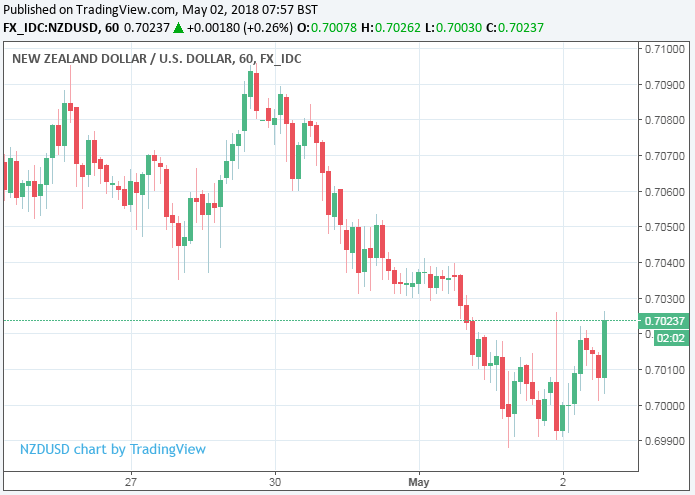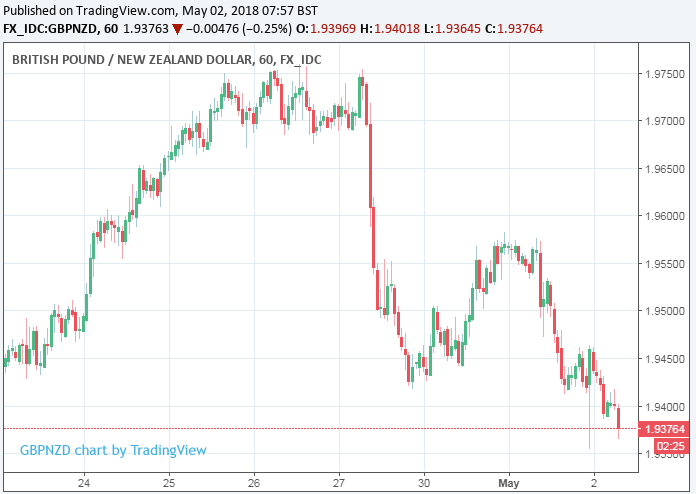The New Zealand Dollar Rises after Unemployment Hits Post-crisis Low but Bounce May be Short-lived
- Written by: James Skinner
-NZD rises after unemployment falls to post-crisis low in first quarter.
-But wages disappoint, suggesting NZD bounce may be short-lived.
-Analysts stay bearish in outlook for NZD as global interest rates rise.

© Natanael Ginting, Adobe Stock
The New Zealand Dollar edged higher during the morning session Wednesday as markets responded to the latest labour market report from the Antipodes, which showed Kiwi unemployment falling to its lowest level since the financial crisis.
Kiwi unemployment dropped 10 basis points to 4.4%, in line with expectations, while the labour force expanded at a faster-than-expected pace of 0.6% during the first quarter of 2018. Markets had looked for jobs growth of 0.5%.
However, on the downside, Kiwi wages grew by just 0.3% during the quarter when markets had been looking for pay growth of 0.5%.
"The Mar qtr employment report was rather strong - but underwhelmed the markets somewhat," says Annette Beacher, chief Asia Pacific macro strategist at TD Securities. "Employment over the past year has been particularly strong in the professional and retail trade sectors, followed by health and education."
Kiwi unemployment now sits substantially below the Reserve Bank of New Zealand estimate of the natural rate of unemployment, which is around 5%, which means the labour market is growing "tighter".
Traditionally, this could be expected to augur inflation pressures and, eventually, higher interest rates. However, as the first quarter wage index number shows, New Zealand pay pressures are still missing in action for the time being.
An eventual uptick in pay growth is crucial for the Kiwi Dollar to stabilise because without this, or a broader uplift in inflation more generally, the Reserve Bank of New Zealand will be unlikely to consider a change in its interest rate policy.
"The RBNZ is presiding over a tightening labour market, but with a sideways step in wages growth there is scope for patience just now. In three month's time when inflation and wages growth are materially higher, that won't be the case," Beacher adds. "For now, the NZD and short-dated OIS remain under pressure as the RBNZ is expected to do nothing on cash rates for the rest of this year."

Above: NZD/USD rate shown at hourly intervals.
The NZD/USD rate received a small boost during the overnight and early morning session in London Wednesday, rising 0.24% to 0.7016, while the Pound-to-New-Zealand-Dollar ratte dropped 0.30% to 1.9380. The Kiwi unit was also higher against all developed world currencies barring the Aussie Dollar.

Above: Pound-to-New-Zealand-Dollar rate shown at hourly intervals.
Wednesday's price action and first quarter labour market report come closely on the heels of a severe sell-off in Kiwi Dollar exchange rates, which has been driven by a shift in global bond yields.
"The selloff has unwound all the gains made during the first two weeks of April and has placed the NZD at a YTD low against the USD. We remain long-term bears on NZD due to weak economic fundamentals," says Gek Teng Khoo, an FX strategist at Morgan Stanley.
US 10 year yields have risen steadily in 2018, from a low of 2.4% to around 3% this week, due to an increase in the supply of American bonds and as markets continue to flirt with the idea that the Federal Reserve could look to increase the pace at which it raises interest rates in the months ahead.
This has seen currency traders refocus on relative interest rates and with the Reserve Bank of New Zealand expected to remain sat on its hands until well into 2019, keeping the Kiwi cash rate its record low of 1.75%, the New Zealand Dollar has lost out to currencies where central banks are likely to raise rates sooner rather than later.
An eventual recovery in wage and inflation pressures is essential if markets are to become willing to bet on a Kiwi interest rate rise sooner rather than later and, in doing so, spare the New Zealand Dollar from further losses.
As things stand, interest rate derivatives market pricing implies the RBNZ will not raise its cash rate until June 2019 although a run of better data could encourage markets to begin betting a rate rise might come sooner. This would be a powerful stimulant for the Kiwi currency in a market where traders are focused keenly on interest rates.
"The RBNZ 'dual mandate' means Governor Orr needs to comment on the state of the labour market at each opportunity, as well as inflation. The next opportunity is 10 May at the Monetary Policy Statement and subsequent press conference where we expect a balanced, not bearish, assessment of the outlook," says TD's Beacher.
Advertisement
Get up to 5% more foreign exchange by using a specialist provider to get closer to the real market rate and avoid the gaping spreads charged by your bank when providing currency. Learn more here.




